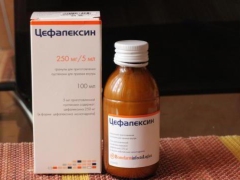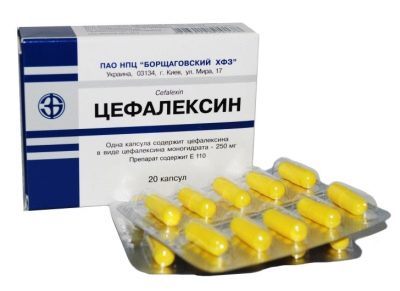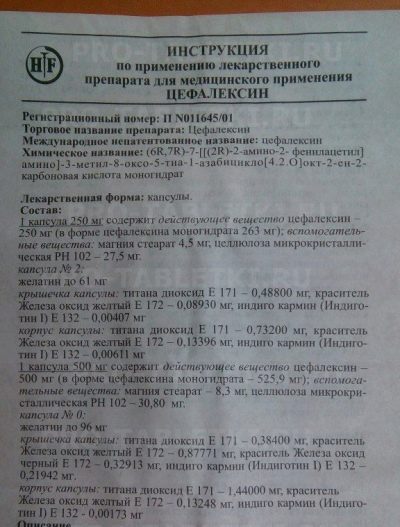Cefalexin for children: instructions for use
Cefalexin is one of the first-generation cephalosporin antibiotics. It is often prescribed for adults with various infections, such as sore throat or bronchitis. Such a medicine is also in demand in childhood. But many mothers doubt whether it is worth giving this drug to a child, because it has a rather low price, and there are three more generations for cephalosporins.
In order for such a drug to really help a small patient, it is worthwhile to find out when its use is justified, what dosages are allowed for children and what harm is possible from using such an antibiotic for a child's body.
Release form
Cefalexin is often presented in pharmacies in the form of suspensions and capsules. Previously, the drug was also released in coated tablets. The drug in suspension is not sold in liquid form, but in granules. It is produced by Hemofarm pharmaceutical company from Serbia.
Such granules have a yellow-orange color, and after combining with water, they produce a yellow-orange suspension, which smells like fruit. Such "Cefalexin" is placed in a dark glass bottle with a capacity of 100 ml in the amount of 40 grams and supplemented with a measuring spoon containing 5 ml of suspension. There is also a risk on the spoon to measure 2.5 ml of such fruit syrup.
Cefalexin capsules produce Hemofarm, Belmedpreparaty and several Russian pharmaceutical companies. Such a drug has a dense gelatin shell of yellow, green or other color, and inside it is a white or white-yellow granular powder. In one package can be 16 or 30 capsules.
Composition
The main component of Cefalexin, which provides antimicrobial action to the drug, has the same name. It is contained in the drug in the form of cephalexin monohydrate. One capsule can hold 250 or 500 mg of this compound, and the dosage of such a substance in 1 ml of suspension is 50 mg, that is, the child will receive 250 mg of antibiotic from five milliliters of liquid medication.
Inactive substances differ in different forms and from different manufacturers. Granules include flavoring agents, guar gum, citric acid, sodium saccharinate, sucrose, and some other ingredients. The capsules have gelatin, dyes, magnesium stearate, MCC and other substances.
If the child does not tolerate any auxiliary ingredients, their composition should be clarified in the paper instructions to the selected Cephalexin.
Operating principle
Like other cephalosporin preparations, Cefalexin is able to destroy various types of pathogenic bacteria by damaging their cell walls (the drug disrupts their formation). The drug has a high activity against many strains of Streptococcus, Neisseria, Staphylococcus, Escherichia coli, Klebsiella and other microorganisms.
However, Cefalexin may not be effective if the disease is caused by certain strains of Proteus, Pseudomonads, Enterococcus, Morganella, and some other microbes.
Indications
The use of "Cefalexin" is claimed:
- with pharyngitis, sore throat, bronchopneumonia, lung abscess, otitis media and other infections of the respiratory system;
- with urethritis, pyelonephritis, cystitis and other bacterial infections of the urinary organs;
- with abscess, pyoderma, furuncle and other infections of the skin or soft tissues;
- with osteomyelitis and infection of the joints.
From what age is appointed?
Treatment with Cefalexin is permitted from birth, but the infants of the first six months of the drug are prescribed with caution. The solid form of the drug can be used from 3 years old, if a single dose for a child, taking into account his weight, will be more than 250 mg and the baby has no problems with swallowing the capsule (it is impossible to pick it up and take only powder), but more often than not before the age of 10 years .
Contraindications
Treatment with Cefalexin is prohibited in case of hypersensitivity to such an antibiotic or another cephalosporin preparation. Suspension is also not prescribed for hereditary pathologies of carbohydrate metabolism, because its composition includes sucrose.
If a child has a bowel disease or kidney failure, the use of a medicine requires the supervision of a physician. The drug should be used with extreme caution and if you are allergic to penicillins or carbapenem drugs, as there is a risk of a cross-allergic reaction.
Side effects
Taking Cefalexin can cause:
- erythema, pruritus, angioedema, urticaria, or other allergic reaction;
- dry mouth, diarrhea, anorexia, abdominal pain, jaundice and other disorders of the gastrointestinal tract;
- thrush in the mouth or intestinal candidiasis;
- pseudomembranous colitis or enterocolitis;
- weakness, dizziness, hallucinations, nervous agitation and other symptoms of a negative effect on the central nervous system;
- leukopenia and thrombocytopenia;
- joint pain and other symptoms.
If any of these ailments occur, it is recommended that you consult a doctor and, if necessary, select another antibiotic.
Instructions for use
Cefalexin in any form is recommended to be taken before meals, as food affects the absorption time of the active compound. It is best to drink a suspension or capsule 30-60 minutes before a meal. Wash down the capsules with water in sufficient quantities.
As the manufacturer notes, for young patients younger than 10 years, a suspension is preferable. If a child weighs less than 40 kg, the daily dosage of the drug for him will be 25-100 mg per kilogram of his body weight.
Clarify the correct daily dose should be a doctor, because it depends on the severity of the infection.
Having calculated the required number of milligrams of antibiotic, it is divided into 4 doses. If the child has a skin infection or streptococcal pharyngitis, the daily dosage prescribed by the doctor is divided into two doses. Small patients with severe disease prescribe the maximum allowable dosage (100 mg / kg) and divide it into 4-6 doses.
To prepare liquid medicine from the granules, you need to pour water into the bottle before labeling and mix well. Since the components of the suspension will eventually settle down, before each use of such “Cefalexin”, the contents of the vial are agitated.
For a child older than 10 years, a single dose of the drug is 250 or 500 mg, so it is convenient to give capsules, but if necessary, treatment can be made in liquid form. In this dosage, the medication is taken every six hours (four times a day), so an average daily dose of the antibiotic is 1-2 grams. If the disease is severe, an increase in dosage is possible, but a child over 10 years old should not receive more than 4 g of the active substance per day.
The duration of taking Cefalexin depends on the diagnosis and reaction to therapy, but on average, the medication is prescribed for a period of 7 to 14 days. In cases where the disease is caused by beta-hemolytic streptococci, the antibiotic should be used for at least 10 days.
It is impossible to stop treatment earlier than the period indicated by the doctor, even if the child’s condition returned to normal.In such a situation, there is a risk that the infection will remain undertreated, and the microbes will become resistant.
Overdose
Taking too much Cefalexin can cause stomach pain, nausea, diarrhea, or vomiting. To eliminate these symptoms, it is recommended to take activated charcoal, and if the general condition worsens, the child should be shown to the doctor.
Interaction with other drugs
If you take Cefalexin together with aminoglycosides, furosemide and other nephrotoxic drugs, the risk of a negative effect on the kidneys will increase. When used with salicylates, antibiotic clearance will slow down. Since Cefalexin can affect prothrombin time, it can enhance the effects of indirect anticoagulants.
Terms of sale
Any form of "Cefalexin" is sold by prescription, so you can buy such an antibiotic only after an examination by a doctor. The average price of one bottle of granules is 60-70 rubles, and about 80 rubles must be paid for 16 capsules.
Storage conditions
Shelf life and pellets in a sealed vial, and capsules is 3 years. It is recommended to keep the medicine at a temperature of + 15 + 25 degrees in a dry place where a small child cannot get it. The finished suspension is not required to keep in the refrigerator - it does not deteriorate at room temperature for 2 weeks. If 14 days have passed since the granules were diluted with water, the medication should be discarded, even if it has not been fully consumed.
Reviews
About treatment of children "Cephalexin" respond mostly well, calling such a medicine affordable and effective. According to moms, in most cases, the drug quickly helped get rid of bronchitis, otitis media, pneumonia, tonsillitis, and other diseases caused by bacteria.
Liquid form of the drug is praised for its pleasant taste, ease of use and the ability to use even the smallest children. Among the disadvantages of the suspension is usually called a short shelf life after dilution with water, and some babies' body reacted to negative cephalexin negative symptoms. In addition, there are reviews, which indicate the lack of therapeutic effect. This happens if the bacterium that caused the infection was insensitive to the active substance of the antibiotic.
Cefalexin capsules also respond mostly positively. According to parents, this is an effective inexpensive antibiotic that has shown itself well in various infectious diseases. But since this is a solid form, it can be difficult for some children to swallow a rather large capsule. Moreover, like a suspension, such “Cefalexin” sometimes provokes negative side effects or does not have the desired effect if the disease is triggered by resistant microorganisms to the drug.
Analogs
If necessary, replace "Cephalexin" with another cephalosporin antibiotic, the doctor may prescribe first-generation drugs ("Cefazolin"," Cezolin "), the second generation ("Zinnat, Axetin, Cefurus or the third generation ("Suprax», «Cefotaxime», «Ceftriaxone», «Pancef», «Cedex"). Many of them are represented only in the powder, which is diluted for intravenous or intramuscular injections, but there are also drugs in suspension or tablets, so it is quite easy to choose the right drug for a child of any age.
If the baby has identified intolerance to Cefalexin, the doctor will prescribe an antibacterial drug that belongs to another group, for example, from macrolides or aminoglycosides. However, these drugs have their own characteristics of use, therefore, the choice of antibiotic as a replacement for Cefalexin should be entrusted to your doctor.
It is unacceptable to give any antimicrobial agent without a doctor's prescription at children's age.
For information on what antibiotics for children exist, see the following video.





























